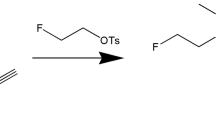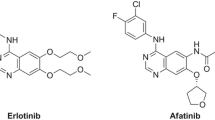Abstract
Purpose
Gefitinib, an inhibitor of the epidermal growth factor receptor–tyrosine kinase (EGFR-TK), has shown potent effects in a subset of patients carrying specific EGFR-TK mutations in advanced non-small-cell lung cancer. In this study, we asked whether PET with [18F]gefitinib may be used to study noninvasively the pharmacokinetics of gefitinib in vivo and to image the EGFR status of cancer cells.
Materials and methods
Synthesis of [18F]gefitinib has been previously described. The biodistribution and metabolic stability of [18F]gefitinib was assessed in mice and vervet monkeys for up to 2 h post injection by both micropositron emission tomography (PET)/computed tomography (CT) scans and postmortem ex vivo tissue harvesting. Uptake levels of radiolabeled gefitinib in EGFR-expressing human cancer cell lines with various levels of EGFR expression or mutation status were evaluated both in vivo and in vitro.
Results
MicroPET/CT scans in two species demonstrated a rapid and predominantly hepatobiliary clearance of [18F]gefitinib in vivo. However, uptake levels of radiolabeled gefitinib, both in vivo and in vitro, did not correlate with EGFR expression levels or functional status. This unexpected observation was due to high nonspecific, nonsaturable cellular uptake of gefitinib.
Conclusion
The biodistribution of the drug analogue [18F]gefitinib suggests that it may be used to assess noninvasively the pharmacokinetics of gefitinib in patients by PET imaging. This is of clinical relevance, as insufficient intratumoral drug concentrations are considered to be a factor for resistance to gefitinib therapy. However, the highly nonspecific cellular binding of [18F]gefitinib may preclude the use of this imaging probe for noninvasive assessment of EGFR receptor status in patients.






Similar content being viewed by others
References
Pao W, Miller VA. Epidermal growth factor receptor mutations, small-molecule kinase inhibitors, and non-small-cell lung cancer: current knowledge and future directions. J Clin Oncol. 2005;23:2556–68.
Saba NF, Khuri FR, Shin DM. Targeting the epidermal growth factor receptor. Trials in head and neck and lung cancer. Oncology. 2006;20:153–61.
Halatsch ME, Schmidt U, Behnke-Mursch J, Unterberg A, Wirtz CR. Epidermal growth factor receptor inhibition for the treatment of glioblastoma multiforme and other malignant brain tumours. Cancer Treat Rev. 2006;32:74–89.
Mendelsohn J. Targeting the epidermal growth factor receptor for cancer therapy. J Clin Oncol. 2002;20:1S–13S.
Kris MG, Natale RB, Herbst RS, Lynch TJ Jr., Prager D, Belani CP, et al. Efficacy of gefitinib, an inhibitor of the epidermal growth factor receptor tyrosine kinase, in symptomatic patients with non-small cell lung cancer: a randomized trial. Jama. 2003;290:2149–58.
Fukuoka M, Yano S, Giaccone G, Tamura T, Nakagawa K, Douillard JY, et al. Multi-institutional randomized phase II trial of gefitinib for previously treated patients with advanced non-small-cell lung cancer (The IDEAL 1 Trial) [corrected]. J Clin Oncol. 2003;21:2237–46.
Wakeling AE, Guy SP, Woodburn JR, Ashton SE, Curry BJ, Barker AJ, et al. ZD1839 (Iressa): an orally active inhibitor of epidermal growth factor signaling with potential for cancer therapy. Cancer Res. 2002;62:5749–54.
Shepherd FA, Rodrigues Pereira J, Ciuleanu T, Tan EH, Hirsh V, Thongprasert S, et al. Erlotinib in previously treated non-small-cell lung cancer. N Engl J Med. 2005;353:123–32.
Cappuzzo F, Finocchiaro G, Metro G, Bartolini S, Magrini E, Cancellieri A, et al. Clinical experience with gefitinib: an update. Crit Rev Oncol Hematol. 2006;58:31–45.
Fowler JS, Ding YS, Volkow ND. Radiotracers for positron emission tomography imaging. Semin Nucl Med. 2003;33:14–27.
Murali D, Flores LG, Converse AK, Barlett RM, Barnhart TE, Armstrong EA, et al. Evaluation of [F-18]Iressa as aPET imaging agent for tumor overexpressing epidermal growth factor (EGFR) receptors. J Labelled Compd Radiopharm. 2005;48:S1–S341.
Seimbille Y, Phelps ME, Czernin J, Silverman DS. Fluorin-18 labeling of 6,7-distributed anilinoquinazoline derivatives, for positron emission tomography (PET) imaging of tyrosine kianse receptors:synthesis of 18F-Iressa and related molecular probes.J Labelled Compd Radiopharm. 2005;48:819–27.
Holt DP, Ravert HT, Dannals RF, Pomper MG. Synthesis of [11C]gefitinib for imaging epidermal growth factor receptor tyrosine kinase with positron emission tomography. J Labelled Compd Radiopharm. 2006;49:883–8.
Wang JQ, Gao M, Miller KD, Sledge GW, Zheng QH. Synthesis of [11C]Iressa as a new potential PET cancer imaging agent for epidermal growth factor receptor tyrosine kinase. Bioorg Med Chem Lett. 2006;16:4102–6.
Swaisland HC, Smith RP, Laight A, Kerr DJ, Ranson M, Wilder-Smith CH, et al. Single-dose clinical pharmacokinetic studies of gefitinib. Clin Pharmacokinet. 2005;44:1165–77.
Blackhall F, Ranson M, Thatcher N. Where next for gefitinib in patients with lung cancer? Lancet Oncol. 2006;7:499–507.
Elkind NB, Szentpetery Z, Apati A, Ozvegy-Laczka C, Varady G, Ujhelly O, et al. Multidrug transporter ABCG2 prevents tumor cell death induced by the epidermal growth factor receptor inhibitor Iressa (ZD1839, gefitinib). Cancer Res. 2005;65:1770–7.
Tai YC, Ruangma A, Rowland D, Siegel S, Newport DF, Chow PL, et al. Performance evaluation of the microPET focus: a third-generation microPET scanner dedicated to animal imaging. J Nucl Med. 2005;46:455–63.
Loening AM, Gambhir SS. AMIDE: a free software tool for multimodality medical image analysis. Mol Imaging. 2003;2:131–7.
Brix G, Zaers J, Adam LE, Bellemann ME, Ostertag H, Trojan H, et al. Performance evaluation of a whole-body PET scanner using the NEMA protocol. National Electrical Manufacturers Association. J Nucl Med. 1997;38:1614–23.
Ortu G, Ben-David I, Rozen Y, Freedman NM, Chisin R, Levitzki A, et al. Labeled EGFr-TK irreversible inhibitor (ML03): in vitro and in vivo properties, potential as PET biomarker for cancer and feasibility as anticancer drug. Int J Cancer. 2002;101:360–70.
Mellinghoff IK, Wang MY, Vivanco I, Haas-Kogan DA, Zhu S, Dia EQ, et al. Molecular determinants of the response of glioblastomas to EGFR kinase inhibitors. N Engl J Med. 2005;353:2012–24.
Paez JG, Janne PA, Lee JC, Tracy S, Greulich H, Gabriel S, et al. EGFR mutations in lung cancer: correlation with clinical response to gefitinib therapy. Science. 2004;304:1497–500.
Pao W, Miller VA, Politi KA, Riely GJ, Somwar R, Zakowski MF, et al. Acquired resistance of lung adenocarcinomas to gefitinib or erlotinib is associated with a second mutation in the EGFR kinase domain. PLoS Med. 2005;2:e73.
Schwartz JL, Tamura Y, Jordan R, Grierson JR, Krohn KA. Monitoring tumor cell proliferation by targeting DNA synthetic processes with thymidine and thymidine analogs. J Nucl Med. 2003;44:2027–32.
Amann J, Kalyankrishna S, Massion PP, Ohm JE, Girard L, Shigematsu H, et al. Aberrant epidermal growth factor receptor signaling and enhanced sensitivity to EGFR inhibitors in lung cancer. Cancer Res. 2005;65:226–35.
Innis RB, Cunningham VJ, Delforge J, Fujita M, Gjedde A, Gunn RN, et al. Consensus nomenclature for in vivo imaging of reversibly binding radioligands. J Cereb Blood Flow Metab. 2007;27:1533–9.
Huang SC, Truong D, Wu HM, Chatziioannou AF, Shao W, Wu AM, et al. An internet-based “kinetic imaging system” (KIS) for MicroPET. Mol Imaging Biol. 2005;7:330–41.
Antunes P, Ginj M, Zhang H, Waser B, Baum RP, Reubi JC, et al. Are radiogallium-labelled DOTA-conjugated somatostatin analogues superior to those labelled with other radiometals? Eur J Nucl Med Mol Imaging. 2007;34:982–93.
Senekowitsch-Schmidtke R, Steiner K, Haunschild J, Mollenstadt S, Truckenbrodt R. In vivo evaluation of epidermal growth factor (EGF) receptor density on human tumor xenografts using radiolabeled EGF and anti-(EGF receptor) mAb 425. Cancer Immunol Immunother. 1996;42:108–14.
Eckelman WC. The application of receptor theory to receptor-binding and enzyme-binding oncologic radiopharmaceuticals. Nucl Med Biol. 1994;21:759–69.
Bonasera TA, Ortu G, Rozen Y, Krais R, Freedman NM, Chisin R, et al. Potential (18)F-labeled biomarkers for epidermal growth factor receptor tyrosine kinase. Nucl Med Biol. 2001;28:359–74.
McKillop D, Partridge EA, Kemp JV, Spence MP, Kendrew J, Barnett S, et al. Tumor penetration of gefitinib (Iressa), an epidermal growth factor receptor tyrosine kinase inhibitor. Mol Cancer Ther. 2005;4:641–9.
Brehmer D, Greff Z, Godl K, Blencke S, Kurtenbach A, Weber M, et al. Cellular targets of gefitinib. Cancer Res. 2005;65:379–82.
Sordella R, Bell DW, Haber DA, Settleman J. Gefitinib-sensitizing EGFR mutations in lung cancer activate anti-apoptotic pathways. Science. 2004;305:1163–7.
Pal A, Glekas A, Doubrovin M, Balatoni J, Beresten T, Maxwell D, et al. Molecular Imaging of EGFR Kinase Activity in Tumors with (124)I-Labeled Small Molecular Tracer and Positron Emission Tomography. Mol Imaging Biol. 2006;8:262–77.
Acknowledgments
We thank Dr. Waldemar Ladno, Judy Edwards, Victor Dominguez, and Dr. David Stout for excellent animal imaging technical assistance and Dr. Nagichettiar Satyamurthy and the UCLA Cyclotron staff for providing the radiolabeled compounds. We thank Dr. Jorge Barrio for allowing us to use the Automatic TLC-Linear Analyzer and Arash Safaei for help with the metabolite and monkey studies. We thank Drs. Henry Huang and Christine Wu for critical reading of the manuscript. This study was funded by the UCLA Institute of Molecular Medicine (DE-FC03-87E60615) and UCLA Lung SPORE (NIH P50 CA9038). All experiments reported in this study were conducted in compliance to laws of the state in which they were performed, inclusive of ethics approval.
Author information
Authors and Affiliations
Corresponding author
Rights and permissions
About this article
Cite this article
Su, H., Seimbille, Y., Ferl, G.Z. et al. Evaluation of [18F]gefitinib as a molecular imaging probe for the assessment of the epidermal growth factor receptor status in malignant tumors. Eur J Nucl Med Mol Imaging 35, 1089–1099 (2008). https://doi.org/10.1007/s00259-007-0636-6
Received:
Accepted:
Published:
Issue Date:
DOI: https://doi.org/10.1007/s00259-007-0636-6




